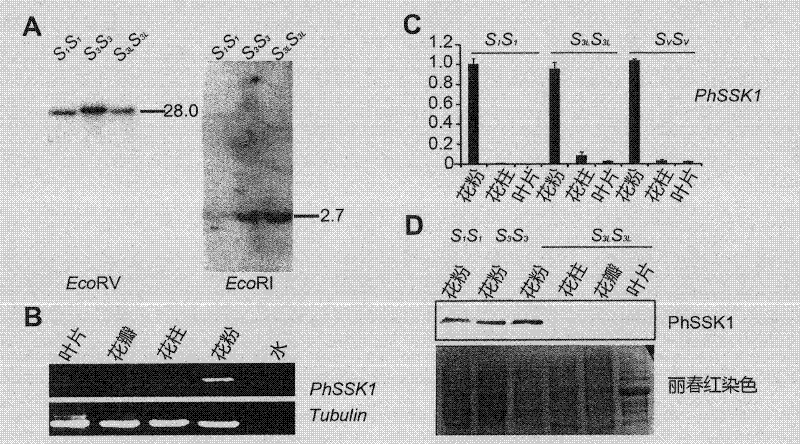Protein involving self-incompatibility and cross-compatibility control of phanerogam pollen, coding gene thereof and application
A technology of flowering plants and compatibility, applied in the field of plant genetic engineering, can solve the problems of health and biological safety of transgenic crops, the inability of transgenic lines to self-fertilize, and the impact on the genetic structure of plant gene pools, etc.
- Summary
- Abstract
- Description
- Claims
- Application Information
AI Technical Summary
Problems solved by technology
Method used
Image
Examples
Embodiment 1
[0049] 1. Petunia material
[0050] The genotype grown in the greenhouse is S I S I , S 3L S 3L , S 3 S 3 , S V S V , S 3L S V and S O S O hybrid petunia, where S represents the genotype of the plant self-incompatibility site (S site), subscript I , 3L , 3 , V and O represent different haplotypes. where S I S I , S 3 S 3 , S 3L S V Purchased from the Department of Life Sciences and Center for Plant Molecular Biology, Northern Illinois University, S 3L S 3L and S V S V The genotype is that we force-pollinate the hybrid petunia by stripping the buds (that is, in the early stage of flower development, before the expression of S-nuclease, that is, when the length of the petunia flower bud is about 3 cm, the petunia is stripped for forced pollination. collected powder) obtained, S O S O It was purchased from Beijing Zhongnong Xintaike Agricultural Technology Company. Among the above petunia materials, S I S I , S 3L S 3L , S 3 S 3 , S V S V and ...
Embodiment 2
[0057] 1. Construction of PhSSK1-RNAi transformation vector
[0058] In order to study the biological function of PhSSK1, we constructed a dual-source transformation vector for reducing the expression of PhSSK1 in petunia pollen by RNAi interference. The construction process is as follows: the original vector used is the pBI101 dual-source transformation vector of Clontech Company, the size of which is 12.2Kb; the promoter of the pollen-specific expression gene Lat52 is connected through HindIII and XbaI [18] ; Since PhSSK1 itself has a 500bp (265-765) intron, therefore, when constructing the RNAi vector, the PhSSK1 gene sequence 1-789 is retained, and the BLAST comparison is carried out in the NCBI database with its CDS sequence, and the downstream of the PhSSK1 coding sequence is selected. From 1-289, the reverse complementary sequence of the specific segment with a length of 289bp is used to construct the siRNA segment, and the entire PhSSK-RNAi transcription region is inse...
PUM
| Property | Measurement | Unit |
|---|---|---|
| length | aaaaa | aaaaa |
Abstract
Description
Claims
Application Information
 Login to View More
Login to View More - R&D
- Intellectual Property
- Life Sciences
- Materials
- Tech Scout
- Unparalleled Data Quality
- Higher Quality Content
- 60% Fewer Hallucinations
Browse by: Latest US Patents, China's latest patents, Technical Efficacy Thesaurus, Application Domain, Technology Topic, Popular Technical Reports.
© 2025 PatSnap. All rights reserved.Legal|Privacy policy|Modern Slavery Act Transparency Statement|Sitemap|About US| Contact US: help@patsnap.com



